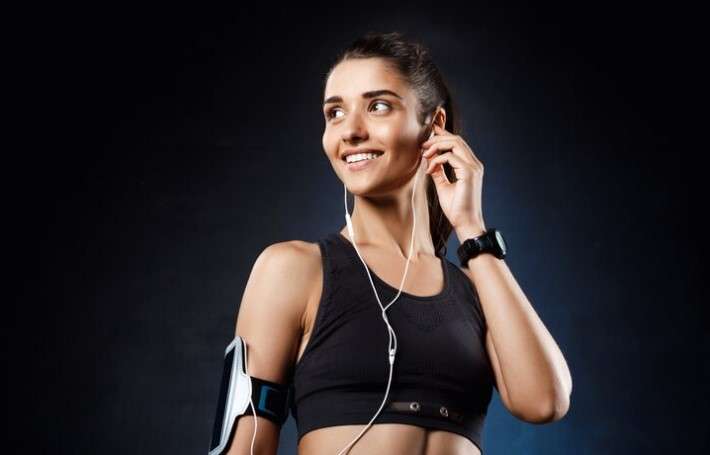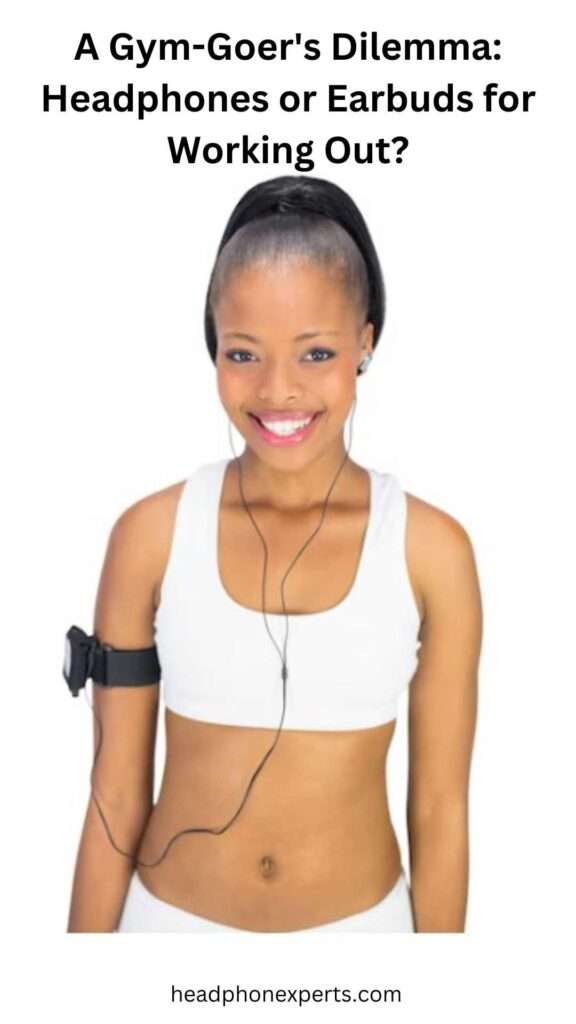When it comes to improving your gym experience, selecting the correct music equipment may make a significant impact in your motivation and performance.
Many fitness lovers face a familiar dilemma: should they wear headphones or earbuds while working out? Each approach has specific benefits and downsides, depending on the type of activity and personal preferences.
In this blog, we’ll look at the key distinctions between headphones and earbuds to help you choose the perfect audio companion for your workout.
Gym-Goer’s Dilemma: Headphones or Earb?
In this Topic we will cover:-
1. Factors to Consider

When deciding between headphones and earbuds for gym use, consider numerous elements that will affect your experience and performance. Sound quality, comfort, fit, and durability are among the most important elements in determining how you engage with and enjoy your training routine.
Sound Quality
Sound quality is an important consideration because it influences how much you can immerse yourself in your workout with music. In general, headphones provide superior noise isolation, which helps to block out ambient gym sounds.
Headphones with larger drivers can also produce a richer, more balanced sound. Earbuds, on the other hand, can provide high-quality sound but lack the depth and fullness of headphones.
High-quality types of headphones and earbuds now frequently contain functions such as bass boost and sound customisation, which improve the listening experience based on user desire.
Comfort and Fit
Comfort and fit are essential, especially for longer workouts. Over-the-ear headphones are often more comfortable for longer periods of time because they distribute weight around the ears rather than pressing into them.
However, they are large and may slip off during strenuous exercise. Earbuds are lightweight and less likely to interfere with strenuous activity, but they might cause discomfort if not properly fitted to your ear canal. Models with ergonomic designs and adjustable tips might provide more stability and comfort.
Durability and Sweat Resistance.
The equipment you purchase must be able to handle the rigors of an exercise, which frequently involves dealing with large amounts of sweat. Workout-specific headphones and earbuds are often sweat-resistant, with sturdy build to withstand drops and harsh handling.
Durability is more than just surviving wear and tear; it also ensures that your investment in audio equipment pays off over time. Always look for IP ratings, since a higher grade means more resistance to dust and water, which is great for any workout situation.
2. Headphones for Working Out

When it comes to headphones, weighing the benefits and drawbacks can help you decide whether they’re the best option for your workouts.
Pros
The benefits of using headphones during exercise include:
- Superior sound quality, including improved bass and soundstage, which can dramatically improve the musical experience.
- Effective noise suppression helps you focus on your training by reducing gym noise.
- Padded ear cups provide long-lasting comfort, especially on sports versions.
Cons
Despite their benefits, headphones have significant downsides.
- The cumbersome design of headphones makes them less suitable for high-intensity workouts, where they may slip off or become a barrier.
- They can trap heat around the ears, which can be uncomfortable during long sessions or in warm weather.
- They are less portable than earbuds and take up more space in your gym bag.
Given these considerations, it’s evident that the decision between headphones and earbuds is heavily influenced by your training style, the value you place on music quality, and your personal comfort preferences. Both alternatives provide distinct advantages, so recognizing these differences will help you make an informed decision that improves your gym experience.
Earbuds for Working Out

Pros
Earbuds are particularly popular among fitness enthusiasts due to several compelling advantages. Firstly, their compact size and lightweight design make them highly unobtrusive, allowing users to engage in vigorous activities without feeling weighed down.
This is especially critical in exercises involving a lot of movement, such as running or high-intensity interval training (HIIT). Additionally, many earbuds designed for workouts come with sweat and water-resistant features, providing durability and enhancing their lifespan even under tough physical conditions.
Another significant advantage is the secure fit offered by various models, which are equipped with customizable ear tips and wings to ensure they stay in place, no matter the intensity of the workout. Lastly, newer models often include advanced technologies like heart rate monitors and fitness tracking, which can be synchronized seamlessly with smartphones to enhance gym routines.
Cons
Despite their advantages, earbuds are not without their disadvantages when used during workouts. One major issue is that they can sometimes offer poorer sound quality compared to full-sized headphones. Bass response, in particular, can be less impactful, which might affect the motivation level of some users who rely on strong beats to stay energized.
Moreover, because they fit directly into the ear canal, earbuds can become uncomfortable over extended periods, potentially leading to ear fatigue. There’s also the risk of them falling out during particularly extreme
activities if they aren’t fitted properly or if the user has not chosen a model specifically designed for sports. Finally, due to their small size, earbuds are easier to lose and might require frequent replacement if not handled carefully.
3. Convenience and Portability

Headphones
Headphones are frequently picked for their sturdy build and higher sound quality, which includes improved bass performance and noise cancellation characteristics. However, when it comes to convenience and mobility for gym use, they might occasionally fall short.
Headphones are thicker, making them less suitable for storage in tiny workout bags. In contrast to earbuds, which may be rapidly stored, they frequently require more careful treatment to avoid damage.
Furthermore, during workouts, the larger size might be a barrier, catching on equipment or being a nuisance when reclining down or performing exercises that require head motions. Nonetheless, headphones are still a feasible solution for folks who value audio quality and do not indulge in frequent high-motion workouts.
Earbuds
Earbuds excel in ease and portability, making them a popular choice among gymgoers. Their compact size enables for simple storage in almost any pocket or small compartment of a workout bag, providing an undeniable advantage in terms of portability.
They also allow for a swift transition from one workout to another without the need to alter or remove bulky equipment from the head. Furthermore, the absence of cords in truly wireless devices avoids the possibility of tangling, increasing the user’s convenience during workouts.
Earbuds are easy to insert and remove as needed, making them ideal for people seeking a hassle-free listening experience when traveling between different gym stations or outdoor locations.
Noise-cancelling feature
Headphones
Noise-canceling headphones are extremely useful for gym-goers who like to remove themselves from their surroundings in order to focus entirely on their activity. Because of their size and shape, these headphones have stronger noise-cancelling qualities.
Active noise cancellation (ANC) technology employs microphones and speakers to filter out external noise, allowing users to concentrate on audio content without increasing the volume too much.
This is especially useful in a noisy gym environment, where the clanging of weights and high-energy music from gym speakers can be disruptive. Furthermore, over-ear headphones typically produce richer, more immersive sound quality, which improves the whole workout experience.
Earbuds
Earbuds, while smaller and less noticeable than headphones, have made major breakthroughs in noise-cancelling technology. Modern high-end earbuds include ANC technologies that successfully decrease ambient noise, enabling for focused listening even in crowded areas such as gyms.
While they may not give the same amount of noise isolation as headphones, their small size and comfortable fit provide an adequate buffer against extraneous noise, allowing the music or podcast to play uninterrupted. Earbuds are especially useful for exercisers who participate in more strenuous exercises because they remain put and are less cumbersome.
4. Price Range Comparison

Headphones
The price of headphones can vary greatly depending on brand, technology, and features. Basic models without ANC can start as little as $20, but they are frequently unsuitable for high-intensity gym use, where durability and sound quality are critical.
Mid-range devices are typically priced between $50 and $200 and frequently offer improved durability, sound quality, and, in some cases, noise-cancelling capabilities. Top-of-the-line models can cost $350 or more, especially for companies known for outstanding sound quality and advanced noise cancellation.
Investing in a higher-priced model often results in greater longevity and increased features that can significantly improve one’s gym experience.
Earbuds
Earbuds are often less expensive than headphones, making them an appealing option for gym-goers on a budget. Basic earbuds can cost approximately $10, but like with headphones, lower-cost models may not deliver the audio quality or durability required for daily gym use.
Mid-range earbuds, which cost between $30 and $100, often provide an excellent blend of sound quality, stability, and moisture resistance, making them perfect for workout.
Premium models with sophisticated features like as high-quality ANC, water resistance, and extended battery life can cost between $150 and $250. These high-end earbuds are built to survive tough workouts while also providing superb music quality.
Frequently Asked Questions
What’s better for working out at the gym, headphones or earbuds?
A: The choice between headphones and earbuds for working out often comes down to personal preference and the type of exercise you do. Here are some factors to consider:
- Comfort: Earbuds are typically smaller and lighter, making them more comfortable for extended wear during workouts. However, some people find headphones with padded ear cups more comfortable, especially during intense workouts.
- Portability: Earbuds are usually more portable and easier to carry around, making them convenient for gym sessions or outdoor activities. Headphones, especially over-ear ones, might be bulkier and less convenient to carry.
- Stability: Earbuds, especially those with ear hooks or fins, tend to stay in place better during vigorous movement like running or jumping. Headphones might shift or fall off during intense workouts, especially if they’re not properly fitted.
- Sound Quality: Generally, headphones provide better sound quality with larger drivers and better isolation from outside noise. However, there are high-quality earbuds available that offer impressive sound performance as well.
- Noise Isolation: In a noisy gym environment, headphones typically offer better noise isolation, allowing you to focus on your workout or music without external distractions. Some earbuds also offer good noise isolation, but it largely depends on the fit and design.
- Sweat and Water Resistance: Both headphones and earbuds come in sweat-resistant and waterproof models, but you should check the specifications to ensure they’re suitable for your workout intensity and environment.
Ultimately, the choice between headphones and earbuds depends on your personal preferences, workout routine, and comfort level. Try out both options to see which one works best for you.
Conclusion
When deciding between headphones and earbuds for your workouts, consider your personal tastes, the type of exercise you do, and your individual sound quality and comfort requirements.
Headphones frequently provide improved sound quality and noise isolation, making them suitable for gym settings. Earbuds, on the other hand, are lighter, less cumbersome, and more resistant to sweat and movement, potentially improving your workout experience.
- Headphones: Ideal for sound quality enthusiasts and less strenuous activities.
- Earbuds: Suitable for high-intensity workouts and those who prefer a more compact style.
In essence, the decision between headphones and earbuds is based on your priorities—whether you prefer the sound quality and noise isolation of headphones or the compactness and sweat resistance of earbuds for your exercise demands.

